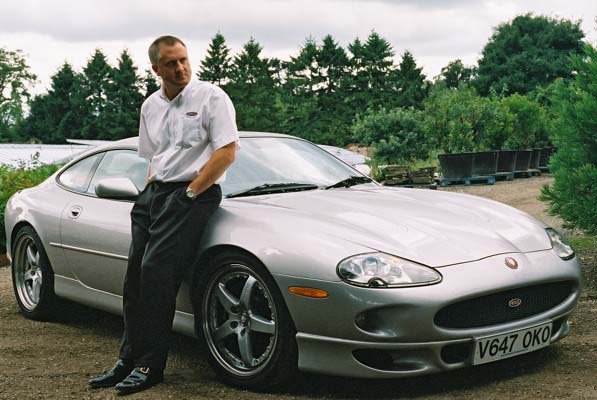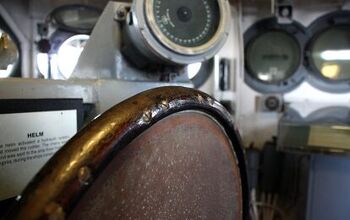Paramount XKR Review
The Jaguar XK8 is a classic. Six years after its debut, the design is still fresh, bold and dramatic. It's one of those cars that somehow looks fast standing still. Okay, viewed from the side, the boot is about two feet too long- thanks to US regulations requiring all expensive cars to accommodate two golf bags. Even so, the Jag rules. Freshened Porsches, Mercs, Beemers and Lexi still can't compete with the XK's svelte aggression. Slinking into the club's parking lot, the Jag proclaims, 'Look out boys, this cat has claws!'
Except it doesn't. Yes, the XK is fast. The standard 4.0 litre car zooms from zero to sixty in 6.6 seconds. The supercharged XKR makes the same dash in 5.1. But anyone who loves life (or hates insurance forms) shouldn't try to carry that speed into a corner. The heavyweight XK8 is a cleverly disguised boulevard cruiser. Ask it to change directions quickly and, well, hippo-type wallowing ensues. It doesn't matter if you try to counter the XK's 'hard-a-starboard' body roll with brakes, acceleration, opposite lock or prayer. Bad things happen. Owners quickly learn to restrict their fun to straight-line blasts or slow motion posing.
In some ways, the XKR is worse. Although it has more power, wider tires, stiffer suspension and slightly better brakes, it lacks the XK's early warning system. A standard car lets you know you're dicing with the limits of adhesion and chassis control before you crap out. The XKR gives you little advance notice of impending chaos, and no quarter when it arrives. It's Blitzkrieg motoring: one second all's right with the world, the next you're upside down in a ditch with the Germans laughing at you.
Luckily for enthusiasts everywhere, a small tuning company called Paramount can give the XK the sporting performance it deserves. And I do mean small; Paramount is to small what Ford is to big. We're talking one mechanic stashed away in the back of the owner's commercial plant nursery, working on one car at a time. Simon Dyer, Paramount's Sales Manager, claims his company breathes its magic on some 150 XKs a year. Maybe. One thing is for sure: a 'normal' XK would take one look at a Paramount XKR 450 Grand Prix and say, 'That's what I want to be when I grow up!'
Hunkering down on lowered suspension, sporting 19' shoes, breathing through a grey mesh grille set in an all-business carbon fibre fairing, Paramount's silver demonstrator bristles with serious intent. The engine provides a suitable soundtrack for the visual assault. A 'normal' XK or XKR sounds like an ant farting in the next room. The Grand Prix is equipped with Paramount's patented 'Tiger Cat' exhaust system. When Simon fired it up, the damn thing growled at me. Given my previous experience, barely catching a tail-happy XKR on a long sweeping bend, I couldn't decide if the newly vocal V8 was issuing a warning or a promise.
Simon took the wheel first. Ignoring hand-drawn signs warning visitors to amble by the greenhouses, Simon left base camp in a Sweeney style spray of gravel. When gravel turned into tarmac, he floored it. The exhaust howled. The supercharger whined. The tyres gripped. We surfed on an endless wave of torque, heading straight for triple digits – and a speed bump. Full anchors yanked us back to a crawl in a bit less than four seconds. It's hard to imagine a salesman from an authorised Jaguar dealer performing that particular party trick. Of course, he wouldn't have the wheels for the job…
We joined the M40 and loped along just under the ton. As I settled into the reworked cabin, I was more than a little put-off by my surroundings. Paramount had replaced all the car's wooden panels with carbon fibre, killing the XK's 'gentlemen's club' serenity. Combined with black leather, the effect was both tasteless and claustrophobic. Paramount's craftsmen would have been far better employed finding a sporting alternative to the standard car's ugly and unsupportive seats.
Simon sang the praises of the basic XK: build quality, reliability and ergonomics. He rattled off the modified car's technical specifications: AP racing brakes and callipers (£3,300), upgraded springs and shocks (£2,800), switchable steering weight (£500), improved air induction system (£370), revised engine management control (£455), etc. Meanwhile, I wondered why Paramount's chief test pilot was demonstrating a sports car on a four-lane motorway.
Ignoring my hints that there's no substitute for personal experience ('My turn! My turn!'), Simon explained that Paramount sends most of its performance parts to the US for dealer fitting. The hairy-chested stuff, like the 450bhp engine upgrade (£6,300), must be installed by Paramount. Guiding him back onto my track I agreed: 'Okay, that's the 'what', Now show me the 'why'.'
We finally made the switch at a lay-by. When I pushed the drilled aluminium accelerator into the black carpet, the car's automatic gearbox was as confused as a sherry-addled pensioner. The box changed down, then down some more, then up a bit, then gave up and stuck us back in top gear. Simon switched on the Grand Prix' sequential gearbox. Unlike the Alfa or Porsche systems, Paramount's wheel-mounted buttons delivered swift, crisp changes, both up and down the ratios. As long as you forget about first gear (the car will pull from standstill in second without a grumble), it's the path to predictable power.
As we crossed the Thames, I recognized one of my favourite hill climbs. Finally, the big cat could stretch her legs. My XKR phobia receded with each corner. Paramount's mods had transformed a squidgy luxury car into a true sports car. Its road manners were impeccable: no body roll, astounding grip and a thoroughly composed and communicative chassis. The Grand Prix just went where she was pointed. Switch off the traction and stability controls, and she still went where she was pointed. Late braking, hard cornering and savage stabs at the go pedal had little effect on the car's poise.
Personally, I told Simon, I think I'd prefer a modified XK, rather than an XKR. I just can't get on with the supercharger's incessant whine. I'd gladly sacrifice 140 horsepower to hear the full glory of an unadulterated V8. Simon says: 'go faster!'
Armed with an assurance that the Jag's portly backside would eventually slide in a predictable and controllable way, I pressed on. Nothing. At speeds that would have thrown a normal XKR at a tree, the Paramount car just got on with the business of cornering. Maybe I could put up with that whine after all. With a more skilled hand at the helm, the 450 Grand Prix would give many an Italian supercar a decent run for its money.
Fans of the legendary Jaguar marque will sit up and take notice at that statement. A Jag that can take on Italian exotics, and still cosset the driver in traditional British luxury? After driving Paramount's XKR, one wonders why Jaguar hasn't heard the news. Surely, Ford's Premium Automotive Group must realise that a 'sporting' XK would find a whole new, non-golfing audience. Besides, why should they leave it to an obscure specialist outfit to show the world that Jaguar's sporting heritage hasn't been lost in Luxury Land?
Simon Dyer suggests Ford may not want Jaguars to outperform their toweringly expensive cousins over at Aston Martin. Or perhaps the marketing boys are holding fire until they can unveil their Boxster-bashing F-type. I suppose it's a question of priorities. Jaguar covets the golf-club set, and thinks the best XK for them is a laid-back cruiser. A small percentage of XK owners disagree. They've decided that classic looks and a smooth ride are crucial, but high performance is Paramount.
More by Robert Farago
Latest Car Reviews
Read moreLatest Product Reviews
Read moreRecent Comments
- Thomas Same here....but keep in mind that EVs are already much more efficient than ICE vehicles. They need to catch up in all the other areas you mentioned.
- Analoggrotto It's great to see TTAC kicking up the best for their #1 corporate sponsor. Keep up the good work guys.
- John66ny Title about self driving cars, linked podcast about headlight restoration. Some relationship?
- Jeff JMII--If I did not get my Maverick my next choice was a Santa Cruz. They are different but then they are both compact pickups the only real compact pickups on the market. I am glad to hear that the Santa Cruz will have knobs and buttons on it for 2025 it would be good if they offered a hybrid as well. When I looked at both trucks it was less about brand loyalty and more about price, size, and features. I have owned 2 gm made trucks in the past and liked both but gm does not make a true compact truck and neither does Ram, Toyota, or Nissan. The Maverick was the only Ford product that I wanted. If I wanted a larger truck I would have kept either my 99 S-10 extended cab with a 2.2 I-4 5 speed or my 08 Isuzu I-370 4 x 4 with the 3.7 I-5, tow package, heated leather seats, and other niceties and it road like a luxury vehicle. I believe the demand is there for other manufacturers to make compact pickups. The proposed hybrid Toyota Stout would be a great truck. Subaru has experience making small trucks and they could make a very competitive compact truck and Subaru has a great all wheel drive system. Chevy has a great compact pickup offered in South America called the Montana which gm could make in North America and offered in the US and Canada. Ram has a great little compact truck offered in South America as well. Compact trucks are a great vehicle for those who want an open bed for hauling but what a smaller more affordable efficient practical vehicle.
- Groza George I don’t care about GM’s anything. They have not had anything of interest or of reasonable quality in a generation and now solely stay on business to provide UAW retirement while they slowly move production to Mexico.




































Comments
Join the conversation